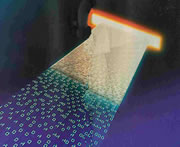| |

Banks and billers face a muddled environment of electronic and paper-based processes.
The latest technology merges mixed payments and streamlines conventional transactions.
|
|
|
|
Streamlining Conventional Payments
Streamlining Conventional Payments
Of
course, as so many bills are still paid by checks and remittances, technology
providers are competing to drive down costs with improvements in automation
equipment and software.
BancTec,
Irving, TX, for one, recently introduced a higher-speed check/remittance transport.
Priced starting at $230,000, the company's new high-volume E-Series transport
is available with optional speeds of 1,200, 1,400 or 1,600 documents per minute
and is intended for mid- to high-volume processing environments handling 100,000
or more transactions per day.
Meanwhile,
BancTec's mid-tier E-Series transport, which processes 550, 800 or 1,150 documents
per minute, will be supported by new software with standard grayscale support,
improved image thresholding, optimized JPEG compression and an ability to capture
up to eight image zones per side.
"We're
focusing on taking image quality to the next level to improve read rates,"
says Dave Conklin, vice president of sales and marketing for BancTec's business
partner solutions. "New image compression technologies such as DjVu and
JPEG2000 will make color and grayscale imaging much more affordable. We're moving
image compression to software to protect the buyer's longterm investment in
this equipment."
High-volume
check imaging demands significant storage investments, but better compression
will make the most of storage while also delivering better images that yield
higher accuracy rates and fewer manually processed exception items.
To
support mixed paper-based and electronic payment environments, BancTec last
year introduced its PayCourier solutions, which provide a common database for
both types of transactions as well as Web-enabled lockbox capabilities for electronic
payments. Web-based search and query s provide access to images and data from
anywhere so that customer service and customer self service initiatives can
be supported.
Next-> Mainstreaming
Payment Automation
|



